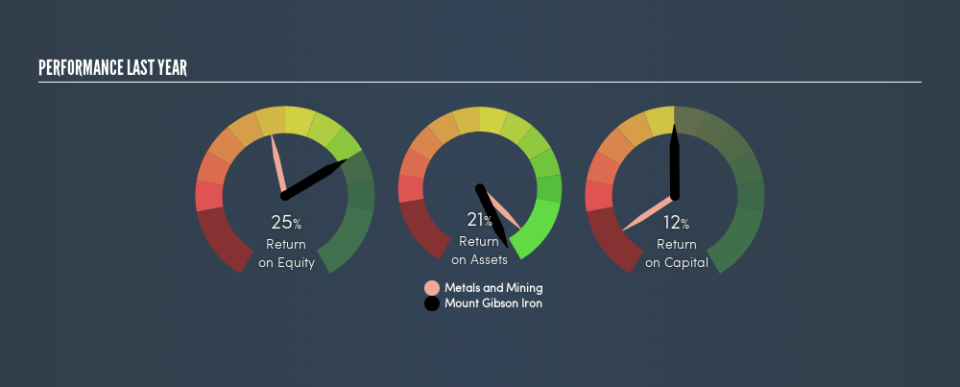Why You Should Like Mount Gibson Iron Limited’s (ASX:MGX) ROCE

Today we are going to look at Mount Gibson Iron Limited (ASX:MGX) to see whether it might be an attractive investment prospect. In particular, we'll consider its Return On Capital Employed (ROCE), as that can give us insight into how profitably the company is able to employ capital in its business.
First up, we'll look at what ROCE is and how we calculate it. Second, we'll look at its ROCE compared to similar companies. And finally, we'll look at how its current liabilities are impacting its ROCE.
Return On Capital Employed (ROCE): What is it?
ROCE measures the 'return' (pre-tax profit) a company generates from capital employed in its business. All else being equal, a better business will have a higher ROCE. In brief, it is a useful tool, but it is not without drawbacks. Author Edwin Whiting says to be careful when comparing the ROCE of different businesses, since 'No two businesses are exactly alike.'
How Do You Calculate Return On Capital Employed?
Analysts use this formula to calculate return on capital employed:
Return on Capital Employed = Earnings Before Interest and Tax (EBIT) ÷ (Total Assets - Current Liabilities)
Or for Mount Gibson Iron:
0.12 = AU$67m ÷ (AU$628m - AU$67m) (Based on the trailing twelve months to June 2019.)
So, Mount Gibson Iron has an ROCE of 12%.
Check out our latest analysis for Mount Gibson Iron
Does Mount Gibson Iron Have A Good ROCE?
One way to assess ROCE is to compare similar companies. Using our data, we find that Mount Gibson Iron's ROCE is meaningfully better than the 9.9% average in the Metals and Mining industry. We consider this a positive sign, because it suggests it uses capital more efficiently than similar companies. Separate from Mount Gibson Iron's performance relative to its industry, its ROCE in absolute terms looks satisfactory, and it may be worth researching in more depth.
Mount Gibson Iron has an ROCE of 12%, but it didn't have an ROCE 3 years ago, since it was unprofitable. This makes us wonder if the company is improving. You can see in the image below how Mount Gibson Iron's ROCE compares to its industry. Click to see more on past growth.
When considering ROCE, bear in mind that it reflects the past and does not necessarily predict the future. ROCE can be deceptive for cyclical businesses, as returns can look incredible in boom times, and terribly low in downturns. ROCE is, after all, simply a snap shot of a single year. Remember that most companies like Mount Gibson Iron are cyclical businesses. Since the future is so important for investors, you should check out our free report on analyst forecasts for Mount Gibson Iron.
Do Mount Gibson Iron's Current Liabilities Skew Its ROCE?
Current liabilities include invoices, such as supplier payments, short-term debt, or a tax bill, that need to be paid within 12 months. Due to the way the ROCE equation works, having large bills due in the near term can make it look as though a company has less capital employed, and thus a higher ROCE than usual. To check the impact of this, we calculate if a company has high current liabilities relative to its total assets.
Mount Gibson Iron has total liabilities of AU$67m and total assets of AU$628m. Therefore its current liabilities are equivalent to approximately 11% of its total assets. A fairly low level of current liabilities is not influencing the ROCE too much.
What We Can Learn From Mount Gibson Iron's ROCE
This is good to see, and with a sound ROCE, Mount Gibson Iron could be worth a closer look. There might be better investments than Mount Gibson Iron out there, but you will have to work hard to find them . These promising businesses with rapidly growing earnings might be right up your alley.
For those who like to find winning investments this free list of growing companies with recent insider purchasing, could be just the ticket.
We aim to bring you long-term focused research analysis driven by fundamental data. Note that our analysis may not factor in the latest price-sensitive company announcements or qualitative material.
If you spot an error that warrants correction, please contact the editor at editorial-team@simplywallst.com. This article by Simply Wall St is general in nature. It does not constitute a recommendation to buy or sell any stock, and does not take account of your objectives, or your financial situation. Simply Wall St has no position in the stocks mentioned. Thank you for reading.

 Yahoo Finance
Yahoo Finance 
